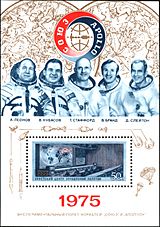Valery Kubasov facts for kids
Quick facts for kids
Valery Kubasov
|
|
|---|---|
 |
|
| Born |
Valeri Nikolayevich Kubasov
7 January 1935 Vyazniki, Ivanovo Industrial Oblast, Russian SFSR, Soviet Union
|
| Died | 19 February 2014 (aged 79) |
| Nationality | Soviet/Russian |
| Occupation | Engineer |
| Awards | Hero of the Soviet Union (twice) |
| Space career | |
| Cosmonaut | |
|
Time in space
|
18d 17h 59m |
| Selection | Civilian Specialist Group 2 |
| Missions | Soyuz 6, Soyuz 19, Soyuz 36/35 |
|
Mission insignia
|
|
| Retirement | November 13, 1993 |
| Signature | |
 |
|
Valery Nikolaevich Kubasov (Russian: Вале́рий Никола́евич Куба́сов) was a famous Soviet and Russian cosmonaut. He was born on January 7, 1935, and passed away on February 19, 2014. Kubasov was a flight engineer on three important space missions.
He flew on Soyuz 6 and Soyuz 19. Soyuz 19 was part of the special Apollo–Soyuz mission, where American and Soviet spacecraft met in space. He also commanded Soyuz 36 as part of the Intercosmos program. On July 21, 1975, after the Apollo-Soyuz mission, Kubasov was the first person to exit the Soyuz spacecraft when it landed. He also performed the very first welding experiments in space with his fellow cosmonaut Georgy Shonin.
Valery Kubasov helped develop the Mir space station. He retired from the Russian space program in November 1993. After that, he became a deputy director at RKK Energia, a major space company.
Contents
Early Life and Education
Valery Kubasov was born in Vyazniki, Vladimir Oblast, which is now in Russia. This was on January 7, 1935. After finishing high school in 1952, he went to the Moscow Aviation Institute. He graduated in 1958 as an aerospace engineer.
He then started working for Sergei Korolev, a very important rocket designer. Kubasov first worked on studies about how rockets fly. He also helped design the Voskhod capsule. He wrote many papers about how to calculate spaceship paths. He earned a Master of Science degree in Engineering.
In May 1964, Kubasov was one of the first civilians to pass medical tests to become a cosmonaut. Two years later, he was officially accepted into the new civilian cosmonaut group. This group included Georgy Grechko and Vladislav Volkov.
Becoming a Cosmonaut
Kubasov's first space mission was the five-day Soyuz 6 flight in October 1969. During this mission, Kubasov and Georgy Shonin did the first welding experiment in space. They used a special furnace called Vulcan. This furnace welded pieces of stainless steel and titanium. Kubasov also tried hand-held welding.
After his first mission, Kubasov started training for the world's first space station, Salyut 1. He trained with Georgy Shonin and Pyotr Kolodin.
In 1971, Kubasov was almost part of the Soyuz 11 mission. He was supposed to fly with Alexei Leonov. However, doctors found a swelling on Kubasov's right lung. They worried he might have tuberculosis. Because of this, the whole Soyuz 11 crew was replaced. Sadly, the backup crew died when their capsule lost air pressure during the flight. Later, it was found that Kubasov's swelling was caused by an allergy to an insecticide.
Apollo-Soyuz Mission
The Apollo–Soyuz Test Project in July 1975 was Kubasov's second space mission. He was the flight engineer for the Soyuz spacecraft. During this historic mission, American and Soviet spacecraft linked up in space. Kubasov spent several hours inside the American Apollo command and docking modules. He even spoke to the U.S. President Gerald Ford on TV. Kubasov told President Ford that they had "good space food... some juice, some coffee and a lot of water."
Kubasov's last spaceflight was on Soyuz 36 in 1980. On this flight, the Soyuz carried Bertalan Farkas, who was the first astronaut from Hungary. Kubasov officially retired as a cosmonaut on November 13, 1993.
Awards and Recognition
Valery Kubasov received many honors for his work as a cosmonaut. He was named Hero of the Soviet Union twice, in 1969 and 1975. This is one of the highest honors in the Soviet Union. He also received three Orders of Lenin.
Other awards include:
- Pilot-Cosmonaut of the USSR (1969)
- Medal "For Merit in Space Exploration" (2011)
- Medal "Veteran of Labour" (1985)
- Tsiolkovsky Gold Medal from the Academy of Sciences of the USSR
- Hero of the Hungarian People's Republic
- Gold medal "For Merit in the Development of Science and Humanity" (Czechoslovakia)
- Medal "People's Technicist" (Yugoslavia)
In 2000, Kubasov was added to the International Air & Space Hall of Fame. This is located at the San Diego Air & Space Museum. In 1976, he won the Yuri Gagarin Gold Medal with his Apollo-Soyuz crewmates, Slayton and Brand.
Kubasov was also an honorary citizen of many cities around the world. These include Vyazniki, Kaluga, Vladimir, Karaganda, Arkalyk, New York City, Houston, San Francisco, Atlanta, Nashville, and Salt Lake City.
Later Life and Legacy
Valery Kubasov passed away in Moscow on February 19, 2014, at the age of 79. He is remembered for his important contributions to space exploration. His work helped advance space welding and international cooperation in space. He is survived by his wife, Lyudmila Kurovskaya, his daughter Ekaterina, and his son Dmitry.
See also
 In Spanish: Valeri Kubásov para niños
In Spanish: Valeri Kubásov para niños


